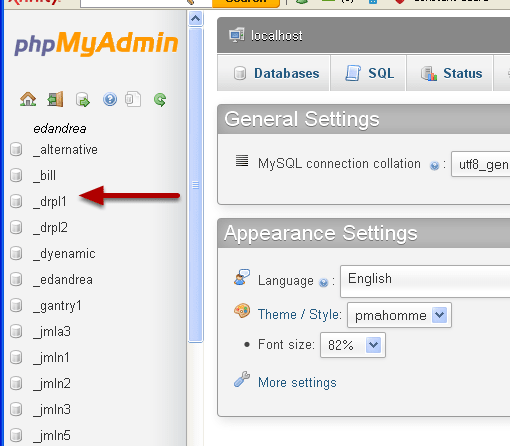

- #Find out localhost phpmyadmin password how to#
- #Find out localhost phpmyadmin password software#
- #Find out localhost phpmyadmin password password#
- #Find out localhost phpmyadmin password free#
Here is an example of what you should see:

Log in to phpMyAdmin by using the following credentials: The SSH session will now include a secure SSH tunnel between the two specified ports.Īccess the phpMyAdmin console through the secure SSH tunnel you created, by browsing to. In the “Session” section, save your changes by clicking the “Save” button.Ĭlick the “Open” button to open an SSH session to the server.

You’ll see the added port in the list of “Forwarded ports”. This will create a secure tunnel by forwarding a port (the “destination port”) on the remote server to a port (the “source port”) on the local host (127.0.0.1 or localhost).Ĭlick the “Add” button to add the secure tunnel configuration to the session. Remember that if you are redirecting HTTP requests to the HTTPS port, you must use destination port 443 instead of 80. In the “Connection -> SSH -> Tunnels” section, add a new forwarded port by introducing the following values: Once you have your SSH client correctly configured and you have confirmed that you can successfully access your instance using SSH, you need to create an SSH tunnel in order to access phpMyAdmin.
#Find out localhost phpmyadmin password free#
In the instructions below we have selected PuTTY, a free SSH client for Windows and UNIX platforms. In order to access phpMyAdmin via SSH tunnel, you need an SSH client.
#Find out localhost phpmyadmin password how to#
TIP: Refer to these instructions to learn how to obtain your private key. Watch the following video to learn how to easily access phpMyAdmin on Windows through an SSH tunnel: In this case, modify the steps below to use ports 81 or 443 respectively instead of port 80 for the tunnel endpoint. Similarly, if you have enabled Varnish (TM) or HTTPS redirection, your stack’s Web server might be accessible on port 81 (Varnish (TM)) or port 443 (SSL). If this port is already in use by another application on your local machine, replace it with any other port number greater than 1024 and modify the steps below accordingly. NOTE: The steps below suggest using port 8888 for the SSH tunnel. IMPORTANT: Before following the steps below, ensure that your Web and database servers are running. This implies that you must be able to connect to your server over SSH in order to access these applications remotely. To access it from a remote system, you must create an SSH tunnel that routes requests to the Web server from 127.0.0.1. Modify the available memory for the virtual machineįor security reasons, phpMyAdmin is accessible only when using 127.0.0.1 as the hostname.Auto-configure a Let's Encrypt certificate.Connect to the virtual machine from another host.Configure the application's IP address or hostname.Learn about the Bitnami Configuration Tool.Configure third-party SMTP for outbound emails.
#Find out localhost phpmyadmin password password#
#Find out localhost phpmyadmin password software#
SFC is a not-for-profit organization that helps promote, improve, develop, and defend Free, Libre, and Open Source Software (FLOSS) projects.Frequently Asked Questions for Virtual Machines The phpMyAdmin project is a member of Software Freedom Conservancy. When the project turned 15, we published a celebration page. PhpMyAdmin is a mature project with a stable and flexible codeīase you can find out more about the project and its history and the awards it earned. To ease usage to a wide range of people, phpMyAdmin is being translated into 72 languages and supports both LTR PhpMyAdmin is also very deeply documented in a book written by one of the developersĮffective MySQL Management, which is available in English and Spanish. You face any problem you can use a variety of support channels to get The phpMyAdmin team will try to help you if PhpMyAdmin comes with a wide range of documentation and users are welcome to


 0 kommentar(er)
0 kommentar(er)
